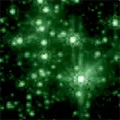CXC Home | Search | Help | Image Use Policy | Latest Images | Privacy | Accessibility | Glossary | Q&A

Into the Milky Way: Quintuplet Cluster
QuickTime MPEG This sequence begins with Chandra's X-ray view of a 900 by 400 light year swath of the center of the Milky Way. It then zooms into a smaller region where large filamentary structures are seen in radio waves. The view moves in even closer to show the Quintuplet star cluster. Named for its five brightest stars at infrared wavelengths, the Quintuplet is known to be home to hundreds of stars. Several of these are very massive stars that are rapidly losing gas from their surfaces in high-speed stellar winds. Collisions from these winds are what astronomers believe to be the source for the point-like concentrations seen in the Chandra image.
[Run Time: 0:24]
(Credits: X-ray: NASA/CXC/NWU/C.Law & F.Zadeh;
IR: NASA/ESO/STScI/D.Figer et al.;
Radio: NRAO/AUI/NSF/F.Zadeh et al.)
QuickTime MPEG This sequence begins with Chandra's X-ray view of a 900 by 400 light year swath of the center of the Milky Way. It then zooms into a smaller region where large filamentary structures are seen in radio waves. The view moves in even closer to show the Quintuplet star cluster. Named for its five brightest stars at infrared wavelengths, the Quintuplet is known to be home to hundreds of stars. Several of these are very massive stars that are rapidly losing gas from their surfaces in high-speed stellar winds. Collisions from these winds are what astronomers believe to be the source for the point-like concentrations seen in the Chandra image.
[Run Time: 0:24]
(Credits: X-ray: NASA/CXC/NWU/C.Law & F.Zadeh;
IR: NASA/ESO/STScI/D.Figer et al.;
Radio: NRAO/AUI/NSF/F.Zadeh et al.)
Return to Quintuplet Cluster (28 Jul 04)


